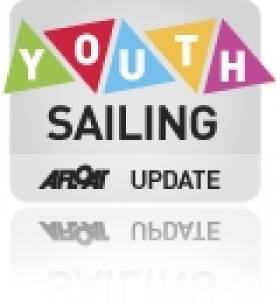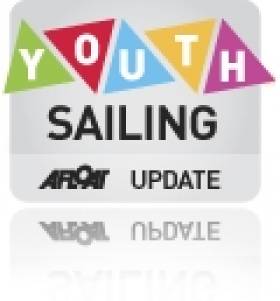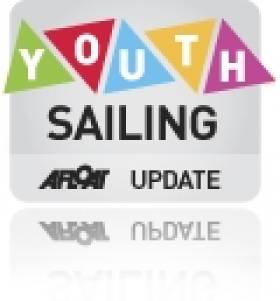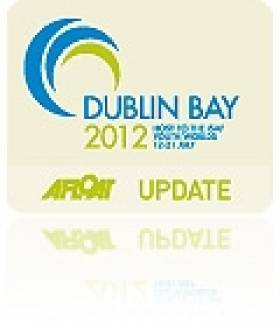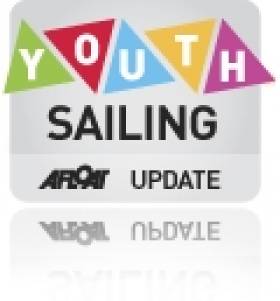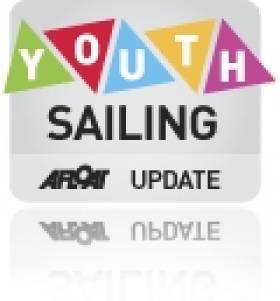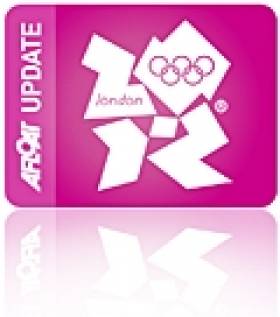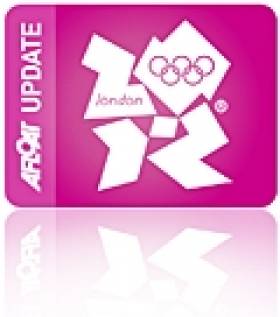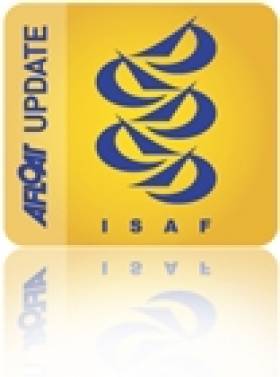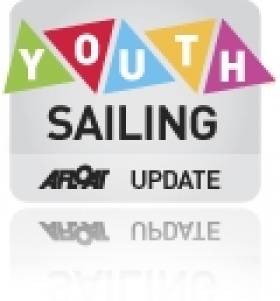Displaying items by tag: ISAF
Murphy Wins Laser Radial Race at Youth Worlds
Very light conditions prevail at the ISAF Youth Worlds in Zadar, Croatia as they do at home but Northern Irish Laser Radial sailor Sophie Murphy held her nerve to deliver a race win in the second race of the day followed by a seventh in the third race having started the day with a disappointing 23rd. Sophie is now in 11th place overall going in to day three of the event.
'The biggest challenge for all sailors is to remain steady throughout the event' says ISA Olympic Coach Rory Fitzpatrick who is with the team in Croatia. Cork girls Emma Geary and Niamh Connolly are certainly showing strong consistency at by scoring a 12th and 14th today which leaving them in 13th position overall.
Boys Laser Radial sailor Philip Doran was lying 4th overnight but had a rather disappointing day but is still 16th place overall. Philip is no stranger to international events. He is a former 4.7 World Champion and the u17 Radial World Champion. He is targeting a top 10 finish overall in this event which does not finish until Friday 15 July
More from ISAF
Italian RS:X Girl Veronica Fanciulli and Korean RS:X Boy Cho Wonwoo have set their stool out early at the 41st ISAF Youth Sailing World Championship in Zadar, Croatia by winning two out of three races each and coming second in the other.
The Italian leads the RS:X Girls overall on four points but Singapore 2010 Youth Olympic Games gold medallist Siripon Kaewduang-Ngam is still on touch after finishing third in both races today to remain in second on ten points.
On her day Fanciulli said, “It is a good day but there isn’t much wind. There is only six knots and over the two races we were all pumping out on the course.
“For me it is a good day because I finished first in the first race and came second in the second race of the day. I am really enjoying it here because it is my first ISAF Youth Worlds and I am high up and I hope to continue it tomorrow and afterwards.”
And Fanciulli added, “I hope tomorrow will be a windier day.”
Meanwhile Audrey Yong (SIN) and Naomi Cohen (ISR) are tied in third place on 14 points each. Yong finished second in Race 2 and sixth in Race 3 and Cohen came seventh in Race 2 and fourth in Race 3.
Poland’s Agnieszka Bilska won Race 3 today but did not finish Race 2 meaning she slips from second overnight to seventh at the close of day two.
Cho Wonwoo (KOR) also enjoyed a successful day in the RS:X Boys winning both of his races to lead the 34 strong fleet. He has a seven point advantage over Louis Giard (FRA) who finished fifth in both races today to sit on 11 points.
On his day Wonwoo said, “I have trained very hard over the last year for this event. There was a lot of pumping out there today due to the light winds.”
Poland’s Pawel Tarnowski finished second and third in his two races today and like Giard has 11 points but trails the Frenchman who won the opening race in Zadar.
It was a long day on the water for the Laser Radial sailors today but the top of the leader board in the Boys fleet is starting to look tight. Oz Adam (ISR) recorded two out of three race wins today, but the Israeli did not finish the fifth race meaning he has to settle for third place on 18 points. Italy’s Giovanni Coccoluto had a good day finishing 4-6-3 and leads the fleet with 14 points followed by overnight leader Maxime Mazard (FRA) who has 17 points. Slovenia’s Zan Luka Zelko won the other race today and is in fifth place.
In the Laser Radial Girls Paulina Czubachowska (POL) has taken the lead after four races following a good day which saw her finish second, seventh and third. Tiril Bue (NOR) moved from 14th overnight to second after winning Race 2 and coming fifth and eighth in Races 3 and 4. Sandy Fauthoux (FRA) won Race 4 and is third on 33 points. Ireland’s Sophie Murphy won the other race today but with 50 points is down in 11th.
Brazil’s Martin Lowy and Kim Andrade retired after finishing Race 1 in the SL16, since then there has been no stopping the boys from Brazil as they’ve won four races in a row. The sailors have discarded their 15th place finish and with a perfect score card they lead New Zealand’s Tomer Simhony and Ellie Louise Copeland who have a net total of 13 points. Philip Hendrickx and Victor Klaas (BEL) are third on 16 points.
In the 29er Carlos Robles and Florian Trittel (ESP) retained their lead following their 3-18-2 card recorded today. With ten points they remain in control and have a five point advantage over Max Deckers and Annette Duetz (NED) who went 9-1-3 today. Jack Douglas Simpson and Logan Dunning-Beck (NZL) were consistent throughout the day coming fifth, second and third to move up to third on 16 points. The days other race wins went to Josh Franklin and Lewis Brake (AUS) and Antoine Screve and Max Agnese (USA).
Lara Vadlau and Tanja Frank (AUT) won Race 2 and came 11th in Race 3 to move to the top of the 420 Girls Standings on 14 points. But for ISAF Athlete Participation Programme sailors Nikole Barnes and Agustina Barbuto (ISV) they proved that consistency is the aim of the game after coming third in both their races today. They sit second on 17 points. Morgan Kiss and Christina Lewis (USA) are tied on 17 points with the U.S. Virgin Islands girls but with their highest finish of fourth coming in Race 2 they are third.
Only one race took place in the Boy’s 420 and it went the way of South Africa’s Edie Lathinen and Joshua Rubenstein. The result moves the pair to the top of the leader board. Puerto Rico’s overnight leaders Raul Rios and Fernando Monllor came 24th today and slipped down to 11th. Floris van de Werkwn and Laurens van dev Werken (NED) are second on 21 points and Australia’s Angus Galloway and Alexander Gough are third on 22 points.
Racing begins at 12:00 local time tomorrow and two races in each fleet are scheduled before a rest day on Tuesday.
Doran Fourth at ISAF Youth Worlds
Wexford's Philip Doran lies fourth overall after an impressive opening two rounds at the 41st ISAF Youth Sailing World Championship in Zadar, Croatia.
Doran who is sailing in the Boys Laser Radial class has scored a 7 and 12 to be three points off third overall in his fifty boat fleet.
Sophie Murphy sailing in the Girls Laser Radial fleet is 19th after a single race in her fleet of 41.
The third Irish boat sailed by Emma Geary and Niamh Connolly, in the girls double handed 420 class, is 14th from 32 countries.
More from ISAF:
Boys 420 ISAF Athlete Participation Programme sailors Raul Rios and Fernando Monllor (PUR) ended the opening day of sailing at the top of the leader board.
The boys, who are benefitting from the coaching of World Youth Sailing Trust coach, Hugh Styles (GBR), ended Race 1 in eleventh place before claiming the bullet in Race 2.
And the Puerto Rican duo were delighted with their performance. Rios said, "It was pretty light and shifty and it was my first bullet. It is a great feeling, this is my third ISAF Youth Worlds and I've struggled a lot in the other two and this one we're really prepared."
And Monllor added, "It was a very nice. Sailing with Raul has been really good and a great experience, he is a really good sailor and having the opportunity to sail with him has been a great pleasure."
Tied on equal points with the Puerto Rican duo is Brazil's Ricardo Paranhos and Patrick Essle. The boys from Brazil finished 4-8 after the opening day of sailing. The Netherlands Floris van de Werkwn and Laurens van dev Werken are third on 13 points tied with Juan Manuel Garcia Rodriguez and Facundo Mario Olezza Bazan (ARG).
Japan's Daichi Mototsu and Yuki Hino won the opening race in Zadar but came 19th in Race 2 to end day one down in ninth overall.
The 420 Girls were the last off the water at 18:30 local time and only managed to fit in one race due to very light winds. Great Britain's Jessica Lavery and Georgina Morthesele won Race 1 followed by Austria's Lara Vadlau and Tanja Frank. Poland's Julia Rokosz and Joanna Szopinska finished third.
The 23-boat 29er fleet saw Carlos Robles and Florian Trittel (ESP) and Norway's Anders Kippenberg and Emil Mellbye claim the day's bullets. But it was the Spaniards who finished the day at the top of the leader board after finishing fourth in Race 2.
The Norwegians had a poor start finishing 17th in Race 1 but bounced back with the bullet in Race 2. They sit eighth.
Max Deckers and Annette Duetz (NED) came ninth and second in the two races today and are six points behind the Spanish 29er pair. America's Antoine Screve and Max Agnese finished 6-5 to end the opening day of sailing in Zadar in third place.
New Zealand's Tomer Simhony and Ellie Louise Copeland lead the SL16 following their bullet in Race 1 and third place finish in Race 2. Belgium's Phillip Hendrickx and Victor Klaas trail the Kiwis by five points. The Belgian sailors finished 4-5 today and Spain's Jordi Booth and Pau Dengra are in third after coming in second behind the Kiwis in Race 1 and finishing ninth in Race 2.
Brazil's Martin Lowy and Kim Andrade retired after the finish in Race 1, but the Brazilians bounced back with a bullet in Race 2 to end the day in ninth.
In the Laser Radial Boys, Maxime Mazard (FRA) had a fantastic day finishing with a third and second place to lead overall on five points. Terence Choo (SIN) came second in Race 1 and finished 13th in Race 2. One point behind in third place is Oz Adam (ISR) who went 12-4 today.
Mazard takes a ten point lead into the second day of sailing but with a lot of racing to come the Frenchman won't be getting carried away.
Only one race was possible in the Laser Radial Girls as the wind died throughout the day. The race win went to Hong Kong's Erica Hok Yan Leung. Sandy Fauthoux (FRA) came through in second ahead of Erika Reineke (USA).
The RS:X Boys and Girls were only able to fit one race in as well. Louis Giard (FRA) won the RS:X Boys race ahead of ISAF APP sailor Cho Wonwoo (KOR). Italy's Mattia Camboni (ITA) finished third.
And in the RS:X Girls Camboni's Italian team mate Veronica Fanciulli claimed the bullet. Agnieszka Bilksa (POL) came second and Israel's Naomi Cohen finished third.
Singapore 2010 Youth Olympic Games gold medallist Siripon Kaewduang – Ngam finished fourth and bronze medallist Audrey Yong (SIN) finished sixth.
Irish Youth Sailors to Compete at Youth Worlds
350 sailors from 60 countries are gathering in the Adriatic town of Zadar in Croatia for the 41st edition of the ISAF Youth Sailing World Championship including four youth sailors representing Ireland in three different classes. The competiton runs from today until July 16th.
Laser Radial Boys
Philip Doran from Courtown Sailing Club in Wexford is attending this event for the first time although he is no stranger to international events. He is a former 4.7 World Champion and the u17 Radial World Champion. Philip will be targeting a top 10 finish overall.
Laser Radial Girls
Sophie Murphy from Quoile Y.C. in Northern Ireland is representing Ireland for the second time having competed in Turkey in 2010 at age 16. After sailing a consistent Irish trials Sophie won the right to take the girls place in the Laser Radial. Her experience of competing in this event last year will undoubtedly count in her favour as many quite simply get overawed by the pomp and ceremony that go along with an event as prestigious as this so expect some solid races from Sophie during the week.
420 Girls
Emma Geary from Royal Cork Yacht Club & Niamh Connolly from Baltimore Sailing Club are both aged 18. While not quite having the same amount of international experience as their team mates they are a very strong partnership together and are ideally suited to the 420. Coach Ross Killian has been putting them through their paces in preparation for the toughest event they will have sailed in so far.
Thursday 07 and Friday 08 sailors will be provided with their boats and equipment and will be briefed with limited on water training before racing commences on Saturday 09 July.
The ISAF Youth Sailing World Championships is ISAF's most prestigious event after the Olympic Games and the ISAF Sailing World Championships. Past notable winners include American's Cup skippers, Chris Dickson (NZL), Russell Coutts (NZL), Dean Barker (NZL); Olympic medallists, Ben Ainslie (GBR), Robert Scheidt (BRA), Alessandra Sensini (ITA), Iain Percy (GBR) and Elise Rechichi (AUS); Volvo Ocean Race sailors like Stuart Bannatyne (NZL) and Richard Clarke (CAN).
Ireland has won the bid to host the 2012 ISAF Youth World Sailing Championships in Dun Laoghaire from 12-21 July 2012. The granting of this prestigious sailing event to Ireland is a major boost to the sport and secures Ireland's position as a prime location for hosting worldclass sailing events. It also establishes Dun Laoghaire as one of the prime major racing locations in the world, capable of running multiple classes and courses to the highest international standard.
As nearly 400 sailors descend on Zadar, Croatia for the 41st ISAF Youth World Championships, representatives of Dublin Bay, the 2012 ISAF Youth Worlds hosts will be on site in Croatia to learn all they can, having recently had a welcome nod of approval from ISAF's Fiona Kidd following her visit to Irish waters. Andi Robertson Reports.
"From what I saw things look to be very much ideal. It is new to us to have the competition spread across three different, adjoining clubs but I am sure that will work well. One yacht club is where the race management is centralised and it is all very manageable from there." Explained Kidd who chaired the ISAF Youth World Championships Sub Committee for eight years and has been involved with the championships since 1994.
"The launching facilities look good enough, boat parking is good everything there in terms of the physical plant all looked good. The accommodation is centralised and directly across the street from the boat park which the athletes really appreciate. It is excellent."
"But the success of these championships is very much down to volunteers and already we can see that there is a really great group of people. I had a tour of all the yacht clubs and they seemed really motivated, excited by the prospect and looking forward to it. I left feeling that it is all in very good hands."
"You have to remember that this event is really unique. It is likened to a mini Olympics and we emphasize that to host venues. At a class championships the sailors book their travel, accommodation bring their boats pay their money and go racing. This event I tell the organisers that from the minute they step off the plane until they go home you are responsible for around 500 sailors, you have to house them, feed them, provide top class racing and make sure they are always safe. Logistically it is big, and so the more volunteers to make it go smoothly, the better." Continues Kidd,
"On top of that it has to feel like something special, something different. So there is strict accreditation and access to the boat park, all modelled on the Olympics. It's important for the sailors it feels different and you don't have anyone wandering around the boat park. It has to feel special. They all have to work hard to qualify to be there, so it needs to feel different."
"The event has grown, now there are between 58 and 60 nations and more than ever the big nations like Australia, New Zealand, Italy, Spain, France, GBR send full teams and it has become the real launch pad for young sailors."
"It has been great to meet the organising teams for 2012, it really gives you a sense of who's doing what and I have a very good feeling about the event already."
"There will be a lot to learn this coming week in Zadar. For the first time ever we are having to split the 420's into flights and rotate them, and the accommodation is quite spread out there, and so we are hoping that it should all be made straightforward next year."
Often a successful ISAF Youth World Championships are the platform for a successful bid to host the ISAF Sailing World Championships, and Kidd confirms that a good Youth Worlds would set Irish sailing in good stead were they to look to hosting the Olympic classes ISAF Worlds in the future:
"Of the eight bids which were made for the ISAF World Championships four had hosted the ISAF Youth Worlds and all would be very capable of hosting the ISAF World Championships."
Sailors Back To Defend ISAF Youth Worlds Titles
The countdown to the 41st ISAF Youth Sailing World Championships to be held in Zadar, Croatia is on with 358 sailors from 59 nations registered to compete from 7-16 July.
Many former ISAF Youth Worlds medallists throughout the years have gone on to achieve greatness in the Olympic Games, America's Cup and the Volvo Ocean Race, and this years athletes will look to follow in the footsteps of their heroes.
In the 29er dinghy, 23 teams and 46 sailors will battle it out in their bid to bring home the gold medal for their nation.
Ireland will not be represented in the 29er class in Croatia.
Gael Jaffrezic and Julien Bloyet (FRA) will be back at the ISAF Youth Worlds to defend the 29er title they won in Istanbul, Turkey last year. The French pair rounded off a consistent week with a bullet in the final race in Istanbul to finish at the top of the podium by six points over New Zealand's Alexandra Maloney and Sam Bullock.
The French pair will be the favourites, but there will be some tough competition from America's Antoine Screve and Max Agnese. Screeve finished third with James Moody in 2010. But now sailing with Agnese, Screeve will be looking to bring home gold in Zadar.
Great Britain's Henry Lloyd Williams and Samuel Batten finished out of the medals in Istanbul by one point over Screeve and Agnese. With an impressive start to the regatta, which saw the Brits go 3-2-1, they faded in the middle, finishing towards the back of the fleet. A year on the Brits will be looking for more consistency as they push for a medal.
Darren Choy and Nathan Tang will be Singapore's 29er representatives. Choy will be looking to use the experience gained from his seventh place finish in the Byte at the 2010 Singapore Youth Olympic Games to good effect. And with many of the 2011 ISAF Youth Worlds athletes new to large scale competition the Singaporeans will look to finish in the medals.
Paul Darmanin won gold for Australia in the SL16 at the 2010 ISAF Youth Worlds as crew of Chase Lurati. One year on and Darmanin is at the helm of the Australian SL16 with Aleks Vucic. Darmanin will be looking to retain the title he claimed last year with his new team mate.
The 14-boat fleet will also feature Denmark's Nicolaj Bjørnholt and Daniel Bjørnholt who will compete in their third ISAF Youth Worlds. The twin brothers first sailed at the 2009 ISAF Youth Worlds in Buzios, Brazil where they finished ninth. A year later they were on the podium receiving the silver medal in Istanbul. With their ISAF Youth Worlds experience the Danes will fancy their chances of capturing the gold medal.
Of the crews who competed last year, alongside the Danes will be South Africa's Matthew Whitehead and Calene Loubser. The 2011 ISAF Youth Worlds will be Whitehead's third in the SL16 after he finished second in 2008 with Michael Ovenstone and eighth with Loubser in 2010.
Sailing begins on Saturday 9 July with 12 races scheduled until Friday 15 July.
The Irish 2011 Youth team is Radial champion Philip Doran of Courtown Sailing Club in the Boys single-handed division in the Laser Radial dinghy and Sophie Murphy of Quoile YC in the Laser in the Girls Division.
In the girl's double-handed dinghy class Emma Geary and Niamh Connolly (Royal Cork YC & Baltimore SC) will race the 420 dinghy.
Next year the Youth World Championships are being held on Dublin Bay.
Funding Announced for ISAF Youth Worlds Sailors
The International Sailing Federation (ISAF) has announced that 27 competitors from 13 nations have been approved to receive funding from the Athlete Participation Programme (APP).
None of the Irish sailors bound for Croatia are named on the APP.
Since 2002 APP funding has enabled over 150 sailors the chance to compete at the ISAF Youth Sailing World Championships. Next year the Youth World Championships are being held on Dublin Bay.
The Irish 2011 Youth team is Radial champion Philip Doran of Courtown Sailing Club in the Boys single-handed division in the Laser Radial dinghy and Sophie Murphy of Quoile YC in the Laser in the Girls Division.In the girl's double-handed dinghy class Emma Geary and Niamh Connolly (Royal Cork YC & Baltimore SC) will race the 420 dinghy.
From the 27 sailors chosen to benefit from APP funding in Zadar there will be nine sailors in the Laser Radial Boys, five in the Laser Radial Girls, six in the 420 Girls, two 420 Boys, three RS:X Boys and two sailors from Hong Kong in the SL16.
Of the 2011 recipients Laser Radial sailor Christopher Sands (BAH), US Virgin Islands 420 pair Nikole Barnes and Augustina Barbuto and Roman Gonzalez representing Puerto Rico in the Boys Laser Radial will benefit from the same support again after receiving funding for the 2010 ISAF Youth Worlds in Istanbul, Turkey.
The APP has given developing sailing nations the chance and opportunity to represent their nation at the premier regatta for youth sailors. Sailors from Botswana, El Salvador, Andorra, St. Lucia and Paraguay have all been given the opportunity to compete on a level playground with developed and experienced sailing nations.
Sailing Club Uskok will host the 41st edition of the ISAF Youth Worlds and the sailors on APP will be able to compete in Zadar with subsidised travel and entry.
They will also benefit from the coaching of Hugh Styles, World Youth Sailing Trust coach, who will guide the athletes. "The Athlete Participation Program will give athletes a chance to experience things outside of what they could possibly comprehend," said Styles. "It will give them a chance to network, see a new cultural dimension, cross boundaries and give new opportunities."
2011 ISAF Youth Worlds APP Athletes
Laser Radial Boys
1. Just Van Aanholt (AHO)
2. Christopher Sands (BAH)
3. Antonio Rojas (COL)
4. Hyeungik Kim (KOR)
5. Scott Anthony Keleous (LCA)
6. Manuel Dussault Gomez (MEX)
7. Federico Cabello (PAR)
8. Jean Paul de Trazegnies (PER)
9. Ramon Gonzalez (PUR)
Laser Radial Girls
1. Macarena Robert Mina (CHI)
2. Elisa Echavarria (COL)
3. Erica Hok Yan Leung (HKG)
4. Stephanie Devaus-Lovell (LCA)
5. Natalia Montemayor (MEX)
420 Boys
1. Paul A Rios (PUR)
2. Fernando Monllor (PUR)
420 Girls
1. Maria Sofia Middelthon Zanartu (CHI)
2. Horwitz Von Appen Nadja (CHI)
3. Maria Jose Cucalon Ramirez (ECU)
4. Andrea Susana Collin Pinto (ECU)
5. Agustina Barbuto (ISV)
6. Nikole Barnes (ISV)
SL16
1. Kenton Shue (HKG)
2. Jonathan Shue (HKG)
RS:X Boys
1. Cho Wonwoo (KOR)
2. Matias Canseco Bazo (PER)
3. Alejandro Monllor (PUR)
How It Works
The Athlete Participation Programme allows athletes, via their MNA, to apply for support in a number of different ways:
Event Coaching/Support
So those athletes which attend the event without a coach or team leader can apply for coaching support.
Entry Fee Subsidy
Applicants can apply for help with the €670 entry fee. They can either ask for help with the whole amount or part of the cost of the entry fee.
Travel Subsidy
To assist in covering the expenses of the athlete's travel, you may apply for a Travel Subsidy to cover either part or the entire cost of their travel. ISAF will reimburse the cost of the expenses upon receipt of the necessary travel documents.
Capsize Costs Annalise Overall Lead in Holland
Irish sailing's golden girl Annalise Murphy has shot to the top of the Laser Radial fleet in strong winds at the ISAF World Cup series in Medemblik today, counting a third in the first race and a second this afternoon to be placed second overall after day one. The National Yacht Club sailor should have won the opener to give here the overall lead but she capsized and got her mast stuck in the mud.
RS900 Put Forward as Women's Olympic Skiff Contender
Following ISAF's final choice of sailing events for the 2016 Olympics, including a women's skiff, RS Sailing has announced it plans to develop the RS900 to compete for this role.
While that selection decision is yet to be made by an evaluation team across a range of designs a more immediate issue for Ireland is trying to find an Irish women's crew to campaign such a boat for Brazil.
There is huge interest in the new skiff style sailing internationally but Ireland have not had a double handed women's dinghy crew since Atlanta 1996 so gauging interest here in the new class might be difficult.
The RS900 will be an all-new boat incorporating developments from the highly respected RS800 hull, a new deck, new wings and a new rig. The RS900 will only go into full production if it is selected for the Olympics.
Early testing of a prototype RS900 has shown the performance can be close to a 49er - with optimised handling targeted to suit ISAF's specified weight range for female teams.
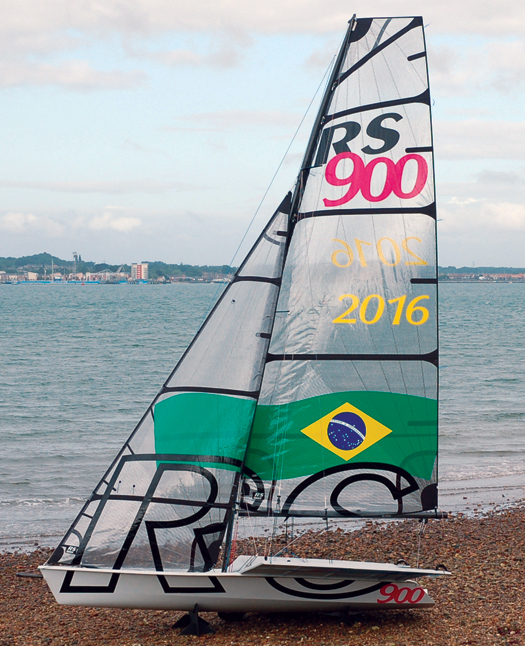
The new RS900 - a new Olympic class?
RS Sailing is also one of the very few companies with proven credentials for the production of one-design race boats in large volumes, plus an established global distribution network – able, therefore, to be a strong partner for ISAF in the successful introduction of a new flagship Olympic event.
"This is a serious project for us" says Martin Wadhams, managing director of RS Sailing. "It will take a great boat to do justice to the Olympic role and a new generation of female sailing athletes. It will also take a significant commitment to work with ISAF on the strategy to launch the new class quickly and effectively if it wins selection. We're up for that."
Nick Peters, head of development at RS Sailing comments "We learned at lot from the initial women's skiff trials at Hyeres four years ago. The RS800 which we took there was perhaps the closest existing class to meet the requirement range of a new Olympic boat – but we understood that the final boat we put forward would need to be more responsive, faster and more challenging to sail. Early sailing of the new RS900 leaves us in no doubt that we have a worthy skiff on our hands. We just need final confirmation of some key evaluation criteria, such as the target sailor weight range, to allow us to confirm we'll undertake the investment needed to compete and then refine the boat to the role."
A number of key features can be seen from the photos, but are liable to change. More technical details will be released as development progresses and all elements are finalised.
ISAF Council voted keelboats out of the Olympics today when the slate, previously adopted by the Events Committee, achieved a majority(19/37) of the votes cast. The news that the Star keelboat would be dropped had been feared for some time. ISAF confirmed events for the 2016 Olympic Sailing Competition last night at its 2011 ISAF Mid-Year Meeting in St Petersburg, Russia. ISAF President Göran Petersson led the ISAF Council in more than three hours of debate and discussion before the ten events were decided. Over 50 Submissions were received for consideration following the changes to the process for selecting events and equipment that was agreed in November 2010.
The ten events selected by the ISAF Council for the 2016 Olympic Sailing Competition are:
Men's Board or Kiteboard - evaluation
Women's Board or Kiteboard - evaluation
Men's One Person Dinghy - Laser
Women's One Person Dinghy - Laser Radial
Men's 2nd One Person Dinghy - Finn
Men's Skiff - 49er
Women's Skiff – Evaluation
Men's Two Person Dinghy - 470
Women's Two Person Dinghy - 470
Mixed Two Person Multihull - Evaluation
The Vote
In November 2010, a provisional list of Events and Equipment ("the slate") was agreed by the ISAF Council. Since then, ISAF received over 50 Urgent Submissions which proposed alternative slates. A two-stage voting process, similar to that used by the IOC when choosing a host city for the Olympic Games, was used to decide the final list.
After the first stage, seven Submissions went through to the second stage of voting. There was a palpable sense of tension in the meeting room as the Council awaited the results of the second stage.
About the ISAF Council
The ISAF Council is the final decision making body of ISAF. It is chaired by the President who was elected along with seven Vice-Presidents for a four year term in 2008. The Council also includes the other members of the Executive Committee, Presidents of Honour and a Treasurer (all non-voting). There are also 29 appointed members who represent each of the regional gropus of sailing nations, and representatives of the Oceanic and Offshore Committee, the ISAF Classes Committee, the Women's Forum and the Athlete's Commission (non-voting).
At the 2010 ISAF Annual Conference, Council agreed that the process for selecting the Olympic Events and Equipment should be changed and approved new Regulation 23.
The report from the Olympic Commission recommended the change as a way to better serve the ISAF Member National Authorities (MNAs) and sailors and to provide greater continuity for the sport between Olympic Games' and create a system for Equipment evolution.
Other decisions made in St Petersburg
A full report of the decisions made in St Petersburg will be published in the minutes, these include:
• Decisions on the core events for 2020 were deferred until the 2011 Annual Conference in November.
• 29er XX granted Recognized Class Status
• 2014 Youth Olympic Games Events confirmed as: Boy's Windsurfer, Girl's Windsurfer, Boy's One Person Dinghy and Girl's One Person Dinghy.
• Olympic Class World Championships set to continue
• A single ranking system for the Olympic events to be operational from 2013 onwards.
Ireland's team for the ISAF Youth World Championships in July does not include either a 420 Boys team or a SL16 catamaran campaign because the Irish Sailing Association qualification standards were not met.
The team for Croatia was announced on afloat.ie immediately after last weekend's Youth Nationals in Dun Laoghaire. A last minute attempt to qualify a Catamaran competing in France narrowly missed the qualification criteria at Carnac, France last weekend.
Despite some fine individual performances by Alex Rumball and Ali Dix – inlcuding a second in class in a long distance race – the newly formed SL16 pairing finished 37th overall in a fleet of 78.
A top 40% overall finishing position is required at predetermined events for team qualification.
Ireland hosts the 2012 ISAF Youth World Championships and the stated aim on Dubin Bay next year is an Irish win in any class so there is naturally an interest in Irish crews gaining as much experience as possible.
Afloat.ie understands there were behind the scenes discussions on the possible expansion of the Irish team for Croatia but last night the ISA issued a statement confirming the youth sailors that will travel to Zadar, Croatia for the ISAF Youth World Championships in 07 -16 July 2011. These are:
• Laser Radial Boys Under 19 – Philip Doran (Courtown Sailing Club/National Yacht Club)
• Laser Radial Girls Under 19 – Sophie Murphy (Quoile Yacht Club, Northern Ireland)
• 420 Girls Under 19 – Emma Geary (Royal Cork) and Niamh Connolly (Baltimore Sailing Club)
The ISA statement says all sailors achieved their international qualification prior to the ISA Mitsubishi National Championships in Dun Laoghaire over the weekend and all sailors finished as top girl or boy in their discipline.
Following their Dun Laoghaire results, the team selection was ratified by the Irish Sailing Association Board of Directors.
This will be Philip Doran’s first Youth Worlds but as a former under 17 world champion the prospect of a major international event such as the ISAF Youth Worlds should not faze him.
At only 17 this is Sophie Murphy’s second Youth Worlds and she is young enough to qualify for 2012 when Dun Laoghaire will host the ISAF Youth Worlds from 12 -21 July, just weeks before the London Olympics.
Emma Geary & Niamh Connolly the double handed team from Cork will be the only 420 on the Irish team as they were the only ones to reach the international qualification. ‘The Irish 420 fleet is a young fleet but there should be great competition for both girls and boys rankings in 2012 when they gain experience and further training.’ stated James O’Callaghan, Olympic Performance Manager ISA. ‘The sailors have now got through the first phase of the process however a lot of hard work and training will be needed between now and then to perform successfully on the international stage’ continued O’Callaghan.
The ISAF Youth World Championship is coming to Dublin 12-21 July 2012 just two weeks ahead of London’s Olympic Games. Over 300 sailors from 60 nations will compete.




























